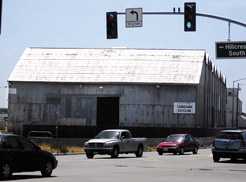
Environmental concerns will be monitored during
deconstruction
The planned eight-month-long demolition of the former GAF
Leatherback property along McCray Street will begin this summer,
with environmental monitoring continuing throughout the
process.
Hollister’s Redevelopment Agency purchased the former roofing
material manufacturer’s two vacant plants
– on seven acres along Hillcrest Road and Prospect Avenue – for
$4 million, with the intention of encouraging non-industrial
development there.
Environmental concerns will be monitored during deconstruction
The planned eight-month-long demolition of the former GAF Leatherback property along McCray Street will begin this summer, with environmental monitoring continuing throughout the process.
Hollister’s Redevelopment Agency purchased the former roofing material manufacturer’s two vacant plants – on seven acres along Hillcrest Road and Prospect Avenue – for $4 million, with the intention of encouraging non-industrial development there.
The Hollister City Council recently approved an environmental report and authorized a mitigation monitoring program associated with the demolition and site clearance at the property, which is designated for mixed-use commercial purposes.
The designation allows for commercial and residential development on the property, located east of downtown. San Benito County YMCA officials earlier this year entered into talks with the city to develop a facility on the southern portion of the property. Housing and residential developments have also been mentioned as possible uses of the land.
“We have an environmental consulting firm that will work on our behalf during the demolition to do additional testing and sign off the site as clear from environmental hazards,” said William Avera, Hollister’s development services director. “There are going to be some unknowns because some of the areas you can’t get into until equipment is moved. The contractors will have an abatement program in place because there is asbestos and lead-based paint that needs to be removed.”
The former Leatherback site has served many purposes through the years, ranging from hay warehouses in 1910 to fruit drying and packaging facilities in the 1920s. Paper manufacturing took place in the area from at least the 1960s through 2007, according to environmental records.
Because of the industrial nature of Leatherback’s operations, an environmental assessment was conducted by Tetra Tech in accordance with the California Environmental Quality Act. The firm, hired by the city, identified numerous “data gaps” – or periods of time in the property’s history in which information about its operations and potential environmental issues is not available.
Tetra Tech’s report said that Leatherback operated “in a time of limited regulation,” so there is the likelihood that hazardous materials were released during that period. The report also could not confirm that the site “has ever been subject to any investigation (in particular, intrusive investigation).”
Tetra Tech recommended that chemical and below-grade water storage areas be investigated “due to the likelihood of past releases during former industrial operations” and that the RDA pursue additional documentation from GAF leatherback “to ensure that sampling for leakage and remediation, if appropriate, were done” as part of the plant’s closure process.
Despite the potential presence of hazardous materials on the site, comprised of three large warehouses, a dryer building, a pulp and batch building and a boiler building, the environmental report states that the findings “generally do not present a threat to human health or the environment … [and] generally would not be the subject of an enforcement action if brought to the attention of appropriate governmental agencies.”
“If during demolition we discover additional things that need special precautions, we’ll do a change order for an environmental firm to do the cleanup,” Avera said. “We need to do it properly. The reality is, with the paper mill site, there are not a lot of hazardous materials out there. We’re talking pretty minimal-type stuff. We’re not talking about a Superfund site. I’m 95 percent convinced that we’re not going to find anything that’s bad and if we do, we can mitigate it.”
The RDA purchase of the former Leatherback property was designed “to get away from industrial uses around the center of town,” Avera noted. “Once the buildings are gone, we’ll feel around what’s out there [in terms of interest from potential developers]. The YMCA is still excited about using the southern part of the property.”
With the economy still in a downturn, he added, “there are not a lot of people that are doing things [development-wise] right now.”
Avera said the railroad track from Hillcrest Road south to Gibbs Road near Rancho San Justo School’s sports complex will likely be removed during the demolition project and replaced with a “parkway and sidewalk so people can get through there.”
The demolition project is expected to go out to bid this month, with those bids due by the end of June. Avera said the deconstruction of the former Leatherback site could be under way by July.









